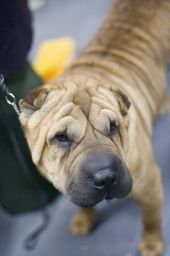
Concerns in the Shar-Pei Breed
Veterinarian Reviewed on April 3, 2013 by Dr. Janice Huntingford
Overview
The Chinese Shar-Pei breed can suffer from a variety of perplexing health problems, including eyelid problems, ear infections, mouth problems, skin fold infections, respiratory problems, renal failure and many other ailments.
Eyelid Problems
Overview
Entropion. The Shar-Pei’s excessive facial wrinkles may cause an inversion or rolling of the eyelids.
Symptoms and Diagnosis
The eyelashes and/or the eyelids’ haired margin may abrade the cornea. Tearing or squinting may result. In severe cases, corneal ulceration and scarring that affects the vision may develop.
Treatment
Young puppies can undergo an eyelid tuck (eyelid tacking) that results in the eyelids being held back. As the lids no longer abrade the eyes, the cornea can heal.
Ear Infections
Overview
Malassezia Pachydermatis or Yeast infections. The Shar-Pei’s small, triangular ears may be prone to ear problems. Poor air circulation to ear canals and problems treating and cleaning ears add the difficulties. Malassezia ( yeast) is present in the normal ear canal. However, heat, moisture, excessive sebum or cerumen production allows the organism to breed.
Symptoms and Diagnosis
Symptoms include itchy, smelly ears with a brown discharge, head shaking and a fishy odour.
Treatment
Treatment for chronic yeast overgrowth includes routine cleaning and prescribed anti-fungals, anti-inflammatories or antibiotics.
Mouth Problems
Overview
Tight lip and Lip Fold Pyoderma. The Shar-Pei may experience mouth problems in the form of tight lip or lip fold pyoderma.
Symptoms and Diagnosis
Tight lip or ‘Labial curl” occurs when a curling lower lip reaches over the lower incisor teeth. The canine does not suffer great difficulties. Symptoms of Lip Fold Pyoderma include the accumulation of water, saliva and food particles that lead to a superficial infection. Symptoms include foul odor from the mouth. With the dog’s excessive lips, brushing teeth is difficult.
Treatment
In serious cases, Tight Lip and Lip Fold Pyoderma require surgical correction. In the latter, surgery will remove the infected tissue fold.
Skin Fold Infections
Overview
Demodectic Mange. Demodectic Mange is a common Shar-Pei health concern. Demodectic mites normally live in the hair follicles in small numbers. In some cases the dog’s immune system is not able to keep the mites under control and they multiply rapidly and cause skin disease.
Symptoms and Diagnosis
Symptoms of localized Demodectic Mange include hair loss, scaly, reddened and inflamed skin lesions on face, trunk or forearms. Diagnosis is made by skin scraping or skin biopsy and finding mites.
Symptoms of generalized Demodecosis include generalized and progressive skin disease that is incurable and life threatening. Secondary infections may complicate the disease.
Treatment
Many dogs are able to resolve this localized mange without treatment, however the Shar-Pei generally requires treatment. Sometimes an insecticide in ointment form or antibacterial gel may be applied. Treatment of generalized Demodecosis may include mitaban dips with mixed response. To avoid passing on this hereditary component, affected dogs should not be bred.
Respiratory Ailments
Overview
Brachycephalic Airway Obstruction Syndrome (BOAS). The many anatomical abnormalities of the Shar-Pei may lead to this respiratory ailment: stenotic snares (very pinched nostrils), elongated soft palate (may interfere with trachea) and hypoplastic trachea (smaller trachea). These abnormalities can decrease the dog’s respiratory reserve.
Symptoms and Diagnosis
Symptoms of BOAS include snuffling, snorting, noisy breathing, coughing, gagging, fainting or collapsing. The Shar-Pei cannot tolerate heat stress or excessive physical exercise. Diagnosis can include assessing under light anaesthesia the soft palate with a long, straight bladed laryngoscope. The palate will obstruct the view of the larynx. A lateral ex-ray of the skull and cervical region can show the length of the airway and soft palate.
Treatment
Surgery is needed to shorten the palate.
Kidney disease
Overview
Renal Amyloidosis. Amyloid deposition disrupts the kidneys. Kidney dysfunction occurs before one year of age; kidney failure by five years of age.
Symptoms and Diagnosis
Symptoms of Renal Amyloidosis include minor weight loss, change in appetite and increased water consumption. Diagnosis is through a urine sample checked every three months. A test of the urine protein level that shows high protein levels may determine kidney disease.
The next level of diagnosis involves a complete blood count, health panel, immune panel, urine protein/creatinine ratio, x-rays and ultrasound.
Treatment
Treatment of Renal Amyloidosis includes dietary management to slow the progress. A low protein diet, restrictions on dietary phosphorous, and introduction of vitamin-mineral supplements can benefit. Fat will help maintain energy density. One cooked egg per day can be served. No cure exists as yet.
Sign up for our newsletter and receive more articles and the latest pet health updates and special offers.
Our Expert
 Dr. Janice Huntingford
Dr. Janice HuntingfordJanice Huntingford, DVM, has been in veterinary practice for over 30 years and has founded two veterinary clinics since receiving her Doctor of Veterinary Medicine at the Ontario Veterinary College, University of Guelph. She has studied extensively in both conventional and holistic modalities. Ask Dr. Jan

